ABSTRACT
THE ICONOGRAPHY OF JOHN KIRKPATRICK (1892-1915), Private John Simpson (No. 202 of the Australian Army Medical Corps) and “Simpson” of the Australian Nation, continues to expand. Australia’s most famous soldier, he is one of only two servicemen to have been commemorated both on the Nation’s coins and stamps. Colonel Edward “Weary” Dunlop was the other. Private John Simpson Kirkpatrick was the first-named serviceperson to have had a full-size statue erected in his honour in Australia, in 1936. His tragically brief (24 days) operational service embodies the highest ethos of sustained gallantry, chivalry and pragmatic self-effacing service to his fellow soldiers.
This paper records new images of John Simpson Kirkpatrick and presents new archival evidence of his early life. Two of his six childhood homes have been identified. Images of the Good Samaritan influence, to which he was exposed in his childhood in South Shields on Tyneside, remain and are here presented. We document new details of his schooling. His first memorial, a statuette entitled “Man with the Donkey” was crafted in 1917 and presented to the South Shields [U.K.] Free Library on the second anniversary of his death. In 2003, on the occasion of the Centenary of the Royal Australian Army Medical Corps, new images of his service continue to be created. We present here a further photo archive of his life and times and several recent examples of the iconic tributes which maintain his name as one of the most revered in Australia.
INTRODUCTION
John Kirkpatrick, “Simpson”, has become the ubiquitous symbol of all that is best in military medicine. A stretcher-bearer of considerable personal strength, his example of valour, gallantry and sustained self-sacrifice unto death combined the theme of the Good Samaritan with the ethos of the most courageous battlefield soldier. As such, “Simpson and his Donkey” have become the proudest of all images of Army health – indeed, one of the proudest of the Australian Nation, which like the conurbation of Tyneside in the United Kingdom, claims him as its own.1.2
Several biographies3-5 and innumerable newspaper and magazine articles have been written about Private John Simpson, Private No. 202 of 3 Australian Field Ambulance of the Australian Army Medical Corps. However, apart from the personal letters, he wrote to his mother, Sarah Simpson (c.1855-1933)7 and to his sister, Annie Kirkpatrick (later Pearson: b. 1894)7 whilst he was a ship’s stoker in Australian waters, no primary sources have been published concerning his pre-enlistment personal life. His letters which have been published3.5 are held in the archives of the Australian War Memorial.3.6.8 Further analysis and interpretation of these letters remain to be undertaken and one military historian at least feels that these surviving archival fragments of his life in Australia still constitute “too many bricks without straw”.
We have recently completed primary research in South Shields, on Tyneside in England’s North East, concerning further details of his childhood. We have identified two surviving homes of the (at least) six in which he spent his childhood. We present images of these and other hit her to unpublished photographs cognate to his early life. New posthumous portrayals and tributes to his life continue to be cre¬ated.9 “Simpson’s” brief service life was a distinctive one and very different from those of other service heroes such as Albert Jacka VC., Sir John Monash and Colonel Edward “Weary” Dunlop. His persona and his association with Gallipoli, however, some¬ how caught the spirit of Australia perhaps seeking national icons after the end of the First World War. We present here images of the life of one of the most famous of all Australian service personnel, if not of all Australians.
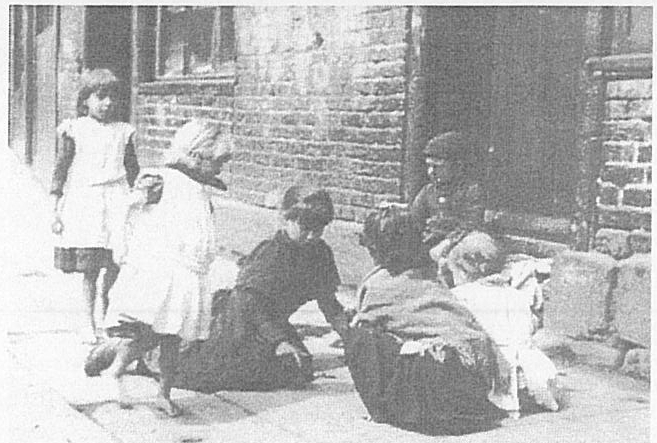
Figure 1: Scenes of “Simpsons” childhood. A photograph of children playing in South Shields, a scene contemporaneous with that of the childhood of John Kirkpatrick (1892-1915). Photograph circa 1900-1910, entitled “A Game of “Chunks'” courtesy of Mr John Moreels and the Ward Philipson Group, Gateshead [U.K.] with acknowledgements.
Figure 2: The childhood home of John Kirkpatrick (1892- 1952), “Simpson”. The streets of his childhood (arrowed)
were some three kilometres from the Tyne River to the east and north. From the Old Ordnance Survey Maps, “Harton 1895” [Tyneside Sheet 16], with acknowledgements. Gateshead [U.K.] with acknowledgements.
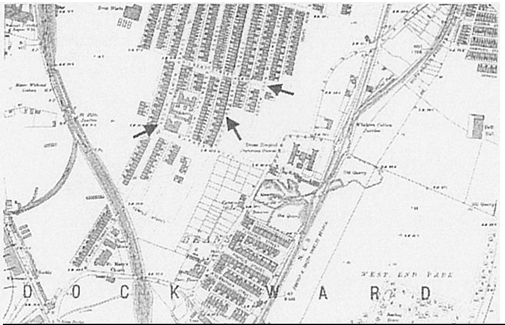
CHILDHOOD SCENES
John Kirkpatrick (1892-1915) was born the illegitimate son of a Tyneside merchant sailor and a domestic servant, Sarah Simpson.10 Neither of his parents now has any marked grave. Confusion continues concerning his correct name. He was born ‘John Kirkpatrick” 10. Surviving archives in South Shields (Tyneside) and at the Australian War Memorial in Canberra show that he was universally called ‘Jack Kirkpatrick” in his child¬hood. He enlisted in the Australian Imperial Force formally under the assumed name of ‘John Simpson”. Posterity has accorded him the posthumous name of “John Simpson Kirkpatrick”, a name he in fact never knew himself. The boy grew up in the densely ¬populat¬ed industrial suburb of Tyne Dock (Figures 1 and 2). That suburb was part of the sea-oriented community of South Shields, then (Figure 1) as now a vigorous city bordered by the southern banks of the mouth of the Tyne River and the North Sea to the east.
We have recently identified six of the sites of his known childhood homes.11 Two of these remain stand¬ing after the post-1960s extensive re-building of Britain’s north-east conurbations. These two surviving homes of “Simpson” have been renovated, but their current portrayal, presented here for the first time (Figures 3 and 4), retain some atmosphere of the terrace life and community in which John Kirkpatrick spent his childhood. For those Australians who find fulfilment in visiting “origins”, these surviving terraces constitute potential sites for latter day visits where one might pause and reflect on the physical environs were developed a young personality of which great courage was a facet. In a similar fashion, many find fulfilment in seeking out the “sites” where lived such as Douglas Bader, Leonard Cheshire V C. and Seaman Evans (of the Scott Expedition).
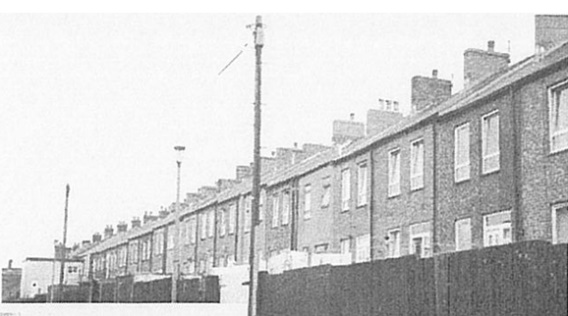
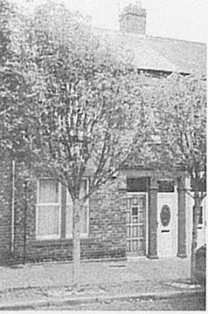
Figure 3A: The rear of “Simpsons” childhood home, centre right, originally a lane for access of the dust cart, now widened by the removal of one parallel row of terrace tenements. Rear of John Williamson Street, South Shields, Ryne and Wear (U.K) Photograph (J.P.), September 2002.
Figure 3B: One (the third) of John Kirkpatrick’s childhood homes at 360 [left-hand door] John Williamson Street, South Shields, Tyne and Wear [U.K.]. “Simpson” was enrolled (on 3 July 1899) at his second school the Barnes Road Boys’ School, from this house. Photograph (J.P.), September 2002.
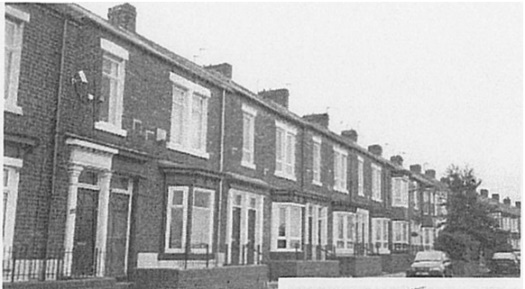
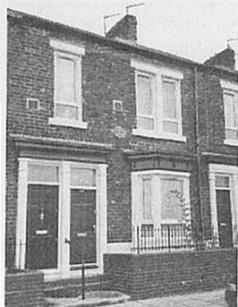
Figure 4A: The surviving homes of the renovated terrace of South Federick Street, South Shields. John Kirkpatrick (“Simpson”) lived at No. 141 (left of the nearest vehicle) in 1903-1904. Photograph (J.P.), September 2002.
Figure 4B: One of the two surviving childhood homes of John Kirkpatrick (1892-1915), “Simpson” of the 3 Australian Field Ambulance. At this home, the fourth of his six-known childhood homes12, situated at 141 South Frederick Street, South Shields, he lived with his parents and sibling in1903-1904. This surviving home has been renovated. Photograph (J.P.), September 2002.
Figure 5: The North Sea beach sands of South Shields where John Kirkpatrick (1892-1915) helped with the control and husbandry of donkeys hired for ¬children’s rides in the months of summer holidays.3 Photograph (J.P.) looking north to the Tyne-mouth and below it the South Shields breakwater, September 2002.

John Kirkpatrick’s service at Anzac Cove was influ¬enced by his childhood experiences with seaside don¬keys3. These were hired to children for beach rides. They formed a recurring annual tableau on the North Sea beach sands at South Shields in the summer months of his childhood (Figure 5). We believe that the boy was influenced in his childhood by the very public promotion of and pride in the Tyneside leader¬ship role of saving life at sea. The lifeboat was invented¬ in 1789 in South Shields several kilometres from his childhood home. He of necessity saw the Tyne Lifeboat being launched and returning from sea and perhaps witnessed the heroic acts of its crew. The Lifeboat Memorial (Figure 6) and its inventor, William Wouldhave (Figure 7) were featured through¬ out his childhood in public monuments and in por¬traits in the South Shields Art Gallery, both within three kilometres of his home.

Figure 6: The plaque on the preserved and publicly displayed Ryne Lifeboat, the June, in Ocean Road, South Shields, U.K. The Lifeboat Memorial, built-in 1887, was a prominent public monu¬ment near the childhood and teenage homes of John Kirkpatrick Photograph, September 2002.

Figure 7: The painting “Willie Wouldhave Inventing the Lifeboat”, by the Tyneside Artist, Ralph Hedley. Together with Henry Greathead (1757-1816), William Wouldhave (1751-1824) invented and built the world’s first lifeboat, the Original, in 1789 in South Shields. The saving of life under circumstances of great personal danger to the rescuers, and the championing of personal courage and gallantry was a very public topic throughout John Kirkpatrick’s; formative years in this community. Photograph courtesy of Mr James Fell, of Tyne and Wear Museums, Tyneside {UK] with acknowledgements.
Lifeboat Memorial (Figure 6) and its inventor, William Wouldhave (Figure 7) were featured throughout his childhood in public monuments and in portraits in the South Shields Art Gallery, both within three kilometres of his home.
In the context of his service as a non-combatant at Gallipoli, with the Red Cross Insignia wrapped around his donkey’s forehead, Simpson was not a pacifist but one who practised a muscular Christianity in the
Good Samaritan (Luke 10:30) ethic. He had been a former gunner, serving as a Volunteer from the age of
17 with the 4th Northumbrian County of Durham (Howitzer) Brigade R.EA. (I.E) [Royal Field Artillery, Territorial Force] 12 This unit, raised in 1908, was part of the South Shields Territorial Force of the Northumbrian Division within Northern Command [U.K.].12 Gunner Kirkpatrick attended weekend encampments on the North Sea where there was an artillery training range at Trow Lea (Figure 8) on the coast south-east of South Shields where he was born, attended school, worked and lived. He remained a “Geordie” to his death, and some Tynesiders remain perplexed at his “adoption” as an Australian, in popu¬lar belief. His popular reassignment as an Australian became intensified after his image was portrayed on Australian stamps in 1965.
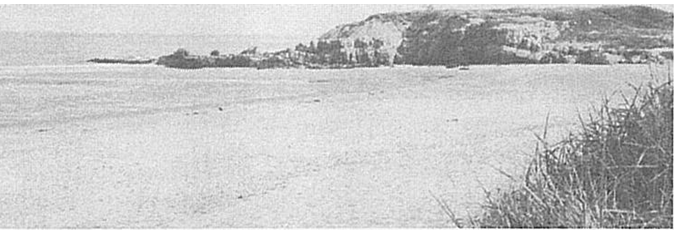
Figure 8: The cliffs and sands of Trow Lea, on the North Sea, 1.5 kilometres south-east of South Shields and less than 3 kilome¬tres from the Tyne Dock district. Here in 1909, Gunner john Kirkpatrick trained with his battery of the 4th Northumbrian County of Durham (Howitzer) Brigade of the Royal Field Artillery (Territorial Force). Photograph (J.P.) looking south-east, showing a heavy artillery gun atop the cliffs, September 2002.
LESSONS FROM CHILDHOOD
Military heroes so often have spent inauspicious or unpromising childhoods. It was asked of the childhood of one of the most famous doctor-soldiers of all, John Hunter: “I wonder what John Hunter was like when he was a farm labourer, as he was until the age of 17, showing no promise in anything?”
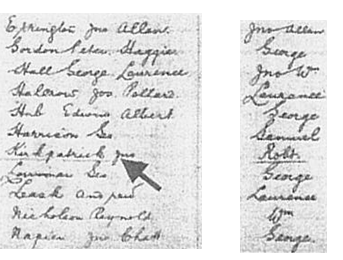
Figure 9: The Admission Register of the South Shields Barnes Road Board School [School No. 1416]. Boys Department Ref T11611-8 (unpag). Registration Entry (No. 2714) for john Kirkpatrick, arrowed. Photograph courtesy of Tyne and Wear Archives, Newcastle-upon-Tyne (U.K.).
Professor Ronald Illingworth in: “Under-achieving Children Destined for Fame”.13
It was this John Hunter, who “showing no promise in anything”13 went on (in 1760) to accept a commission as an army surgeon, and in 1790 to be appointed Surgeon General and Inspector General of Hospitals to the British Army.
Other great soldiers with inauspicious childhoods were Robert Clive (1725-1774), “Clive of India” 14, of whom Macaulay said, “The general opinion of him was that he was a dunce”.15 In a similar vein, the Duke of Wellington “made only slow progress at school and in one examination was 53rd out of 71”. 15 One biographer of Winston Churchill recorded that the latter “passed into Harrow at the bottom of the lowest form, and never moved out of the lower school for the whole of the five years he was there. He remained per¬petually bottom of the class and did not excel in sport”. 15 Major General Orde Wingate (1903-1944) “seemed [in his childhood at Charterhouse School] to be one of the hundreds of difficult little boys”.16 Lord Baden-Powell, he of Mafeking, had “such an undistin¬guished school life that he was rejected as unsuitable for Christchurch College and for Balliol College at Oxford University”, even although his distinguished father was a professor there.
In this context, there are almost no primary archival resources surviving of John Kirkpatrick’s childhood. He commenced schooling at the Barnes Road Infants’ School in 1898 when he was six years old. In July 1900, he transferred to the South Shields Barnes Road Boys’ School, administered by the South Shields Barnes Road Board School Boys’ Department. His admission number was 2714 (Figure 9).

Figure 10: The Mortimer Road Council School, South Shields, Tyne and Wear. John Kirkpatrick (1892-1915), [No. 202, Private john Simpson of 3 Australian Field Ambulance] attended primary school here from 1903 until he left to become a delivery boy for a daily company in 1905. Two memorial prizes – one for an annual essay prize and one for swimming – were awarded until the 1960s. One of the buildings of this School was named the Kirkpatrick House Block until 1984. This building was demolished in 1990, prior to school rebuilding. Photograph, circa 1985, courtesy of the Archives, Tyne and Wear, Newcastle-upon Tyne (U.K.).
John Kirkpatrick’s third school was the Mortimer Road Council School, in South Shields (Figure 10) which he attended from September 1903 until the minimum time that he could legally leave school, at the age of 12 years, in 1905. There were three John Kirkpatrick memorials at his old school; an essay prize, a swimming prize and the Kirkpatrick House Block, a school building extension named in his honour. The first two of these were discontinued in the 1960s and the third demolished in 1984.
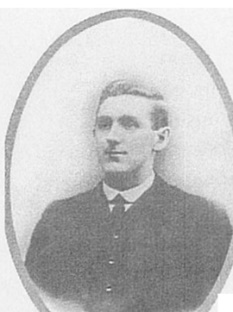 POSTHUMOUS IMAGES
POSTHUMOUS IMAGES
There are but two known photographs (Figures 11 and 12) of John Kirkpatrick, copies of which are held both in the South Shields [U.K.] Public Library (Research Section) and in the Simpson Files of the Australian War Memorial. They are reproduced here.
Figure 11. The only known photograph portrait of John Kirkpatrick (1892-1915), taken in Australia in 1913. Photograph courtesy of the Research Section of the South Shields Public Library, South Shields, Tyne and Wear [U.K.] with acknowledgements.

Figure 12: Private John Simpson John Kirkpatrick, No. 202 of 3 Australian Field Ambulance, in training camp in Western Australia after his enlistment in the 1st Australian Imperial Force in August 1914. Simpson is fourth from left, in the pale vest with out a shirt. Photograph courtesy of the Research Section of the South Shields Public Library, South Shields, Tyne and Wear [U.K.] with acknowledgements.
John Kirkpatrick’s status as perhaps the best known “Australian” stems from his gallantry during a brief 24- day period at Anzac Cove. His named memorial inscriptions date from a temporary wooden cross at Anzac Cove itself, a short-lived memorial which was later replaced by a headstone. Professional tour guides at Anzac Cove have told one of us (J.P.) that, in the twenty-first century, this headstone is the most sought out point of interest, even pilgrimage, by tens of thousands of Australians and New Zealanders each year.
The first permanent memorial to Simpson was a small bronze statuette, entitled “Man with the Donkey”, sculpted by the Tyneside artist, Bertram Pegram in 1917. It was purchased by five masonic philanthropists of Lord Barnard Lodge, Tyne Dock, South Shields, for £50. This group, in turn, presented the statue to the South Shields Free Library in May 1917, on the second anniversary of John Kirkpatrick’s death. This gift was recorded in the South Shield’s Free Library Gazette of the 17th May, 1917.1 Occasional newspaper articles16 and Memorial services in South Shields have continued since that time (Figure 13).
Besides his initial wooden grave-cross at Anzac Cove, and the bronze statuette in South Shields, his third memorial was the inscription of his name in the War Memorial in the old St Mary’s Church, Tyne Dock, subsequently relocated to South Eldon Street where it stands today (Figure 14).

Figure 13: The Programme Card of the 50th Anniversary Tribute to John Kirkpatrick (1892-1915), Pte John Simpson [No. 202 of 3 Australian Field Ambulance], held in the suburb of his birth and childhood, in South Shields, Tyne and Wear [U.K.]. Courtesy of the South Shields Public Library, with acknowledgements.
Figure 14A: The restored First World War Memorial, South Eldon Street, South Shields X relocated to this site after the demolition of St Mary’s Church, nearby, where John Kirkpatrick had attended Sunday School, circa 1900. This was the third memorial to “Simpson”. Photograph (J.P.), September 2002.
Figure 148: The names of Ryne side soldiers and sailors hilled in the First World War, listed alphabetically on each of the Jour faces of the First World War Memorial, South Eldon Street, South Shields. The regrettable graffiti is ubiquitous on all memorials in less-affluent areas. Photograph (J.P.), September 2002.
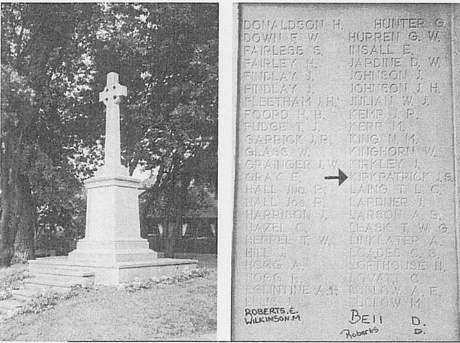
The popular and ubiquitous image of him bringing in a wounded Anzac supported on “Murphy”, his don¬key, is in fact modelled not on Simpson, but on a New Zealand stretcher-bearer, Richard Henderson, a Military Medal winner also from Anzac Cove. After Simpson was killed on the 19th May 1915, Private Dick Henderson, a stretcher-bearer of the New Zealand 1st Field Ambulance, found the donkey wandering “round the shell-torn beach, and carried on the good work”. A photograph of Henderson was taken by Mr J.G. Jackson, at Gallipoli, later of Dunedin. 17 Using this picture, Mr H. Moore Jones, of Auckland, painted the scene from the photograph, and entitled it “Simpson and his Donkey”. Mr Moore Jones sold the painting to the Auckland Commercial Travellers Club (“for about £300”).18 A copy of the painting was sent to Scotland for lithographic reproduction, just prior to the death of the artist who was killed in a fire at the Hamilton Hotel, Dunedin.

This evocative painting has touched the hearts of millions; and has been used as the inspiration for stat-ues, coins, postage stamps, prizes, statuettes and medal¬lions, in at least five nations – the United Kingdom (Figure 15), Australia (Figure 16), New Zealand, Papua New Guinea and Nauru. An early statue of Simpson was unveiled at Ararat, Victoria. The second of the Australian statues of “Simpson and his Donkey” was sculpted by Wallace Anderson and unveiled by lord Hunting field near Melbourne’s Shrine of Remembrance in August 1936 (Figure 16). Although Simpson’s name is not specifically mentioned on the plinth, the caption to him reads “The Man with the Donkey – the Valour and Compassion of the Australian Soldier”. With formal Municipal or State authority, only five statues have been raised to the memory of Australian soldiers, Simpson being the first. The others are Major General Sir Talbot Hobbs (unveiled in 1938, in Perth); General Sir John Monash (1950, in Melbourne); Field Marshal Sir Thomas Blarney (1960, in Melbourne) and Major General Sir Thomas Glasgow (1966, in Brisbane).

Figure 17: An Australian five-dollar coin minted in 1995 depicting on the reverse, “Simpson and his Donkey”. The Royal Australian Mint, Canberra.
An Australian five dol¬lar coin (Figure 17), the senior award of the Returned Services League of Australia (Figure 18), and numerous medallions have been struck which portray the iconic theme of “Simpson and his Donkey”.

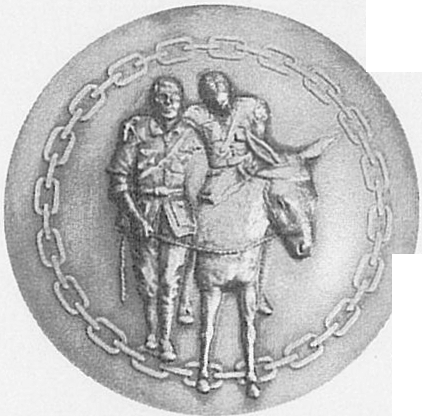
Figure 18B: The Reverse of the Anzac of the Year Award of the Returned and Services League of Australia. Reverse: This Medal (Figure 18A and 18B) was awarded to Lt. Colonel Robert Pearce AM, RFD, later (from 2002) the Honorary Colonel of the Royal Australian Army Medical Corps (Western Australia). Photograph courtesy of Dr Robert Pearce of Perth, with acknowledgements.
The donkey himself has also been the subject of memorialisation. Irresolvable confusion abounds as to the name of this much-loved animal. Variously called “Murphy”, “Duffy”, “Duffy One”, “Duffy Two”, or “Abdul”, all these names have been recorded in various secondary reports, dating from 1917.’ Confusion exists because of the metonymic association between one of Simpson’s nicknames, “Murphy”, itself. As a metonymic symbol, the donkey mascot of the Royal Australian Army Medical Corps was named “Simpson” as part of this ubiquitous iconic theme. The donkey, “Murphy” himself, was posthumously awarded the Purple Cross, of the World Society for the Protection of Animals, on the authority of the RSPCA Australia, on 19th May 1997 (Figure 19). The citation reads:
“For all the donkeys used by John Simpson Kirkpatrick… for the exceptional work they performed on behalf of humans while under continual fire at Gallipoli during World War One (1915)”.
The depiction of Simpson and his donkey, and of the heroic saving of life personified by their actions, continues to inspire artists, sculptors and medallists; and those who see merit in continuing to bring the virtues of self-discipline, humility, resolve and courage before society, in times when such virtues are threatened by alternative trends. As recently as 1991, a new pub, “Kirkpatrick’s” (Figure 15), was opened in South Shields, beside the statue of Simpson and his donkey, in Ocean Road, South Shields.
We have entitled this new photo archive, “A Short Life Rich in Images”. John Kirkpatrick’s life was indeed short. He is known to the world only because of a 24-day window-of-time during operational service. The iconography which he inspired contains many messages – courage and gallantry, equanimity, pragmatic resolve in the Good Samaritan tradition, humility in his work with a donkey and his independent spirit. In this latter context, General C.H. Brand, the Chief of the General Staff of the Australian Defence Force (on Anzac Day 1929), recorded:
“Let it be said, in support of the Officers [at Anzac Cove] that no rule or regulation was quoted as a rea¬son for hindering Simpson’s enterprise… Kirkpatrick was allowed to function as a separate unit, and he reported to the Ambulance [3 Australian Field Ambulance] only once a day”

Figure 19: The Purple Cross Medal, awarded to the donkey, “Murphy”, of Private John Simpson John Kirkpatrick (1892-1915)] in May 1997 IX on the 82nd Anniversary of Simpson’s death at Anzac Cove. The Purple Cross Medal is awarded for “exceptional work in the saving of human life” by the World Society for the Protection of Animals. Such is awarded in Australia under the auspices of the Royal Society for the Prevention of Cruelty to Animals, Australia. This medal, with its citation, hangs near the office of the Surgeon General, The Defence Health Service, in Campbell Park Offices, the Department of Defence, Canberra, Australia.
The fragmentary archives which remain of Simpson’s life reveal him as a slightly iconoclastic youth with a spirited sense of humour. His independent spirit, his wry eschewing of humbug and his “getting on with the job” at Anzac Cove under prolonged mortal risk, are of a flavour which is at variance with the reverence which has been engendered by the iconography which records his life and works. Such virtues, however, have come to transcend the individual and his legacy remains an inspiration for all who have become acquainted with his life.



